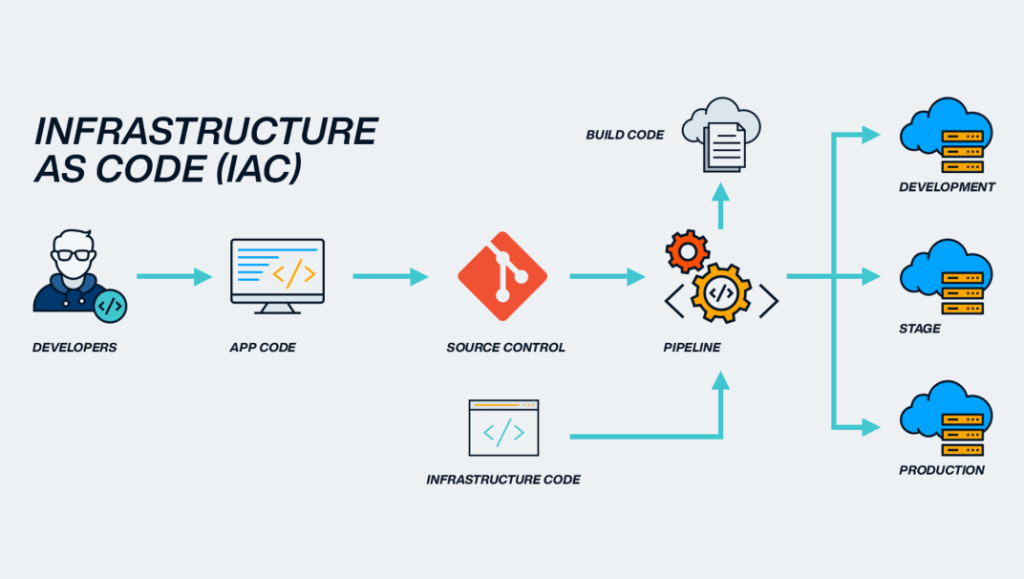
Introduction to Infrastructure as Code (IaC)
Infrastructure as Code (IaC) is a key practice in modern DevOps that allows you to define and manage your cloud infrastructure using code. With IaC, manual processes of configuring and provisioning servers, networks, and databases are automated through scripts. This practice helps in maintaining consistency, reducing errors, and scaling infrastructure efficiently.
Key Features of Infrastructure as Code
- Version Control: IaC scripts can be stored in version control systems (like Git), providing historical records of infrastructure changes.
- Automation: Automates the creation, management, and scaling of infrastructure resources, reducing manual intervention.
- Consistency: Ensures that environments are configured consistently across development, testing, and production.
- Cost Efficiency: By automating resource management, IaC minimizes resource wastage and optimizes costs.
- Scalability: Makes it easier to scale infrastructure up or down based on demand, ensuring efficient resource allocation.
Benefits of Automating Cloud with Infrastructure as Code
Automating cloud resources with IaC provides numerous benefits to organizations, especially in terms of speed, efficiency, and risk mitigation.
Advantages of Using IaC for Cloud Automation
- Faster Deployment: Infrastructure can be provisioned in minutes instead of days, speeding up the deployment process.
- Reduced Errors: Automation eliminates human errors associated with manual configuration, ensuring more reliable environments.
- Consistency Across Environments: IaC guarantees that environments (dev, staging, production) are identical, avoiding discrepancies.
- Reusability: Code can be reused across multiple projects or environments, ensuring scalability and efficiency.
- Improved Collaboration: Teams can work collaboratively on infrastructure changes using version-controlled IaC files.
Key Tools for Infrastructure as Code
To automate cloud infrastructure effectively, several IaC tools can help streamline the process. These tools support different cloud platforms and provide varied features for managing infrastructure.
Popular IaC Tools for Cloud Automation
- Terraform: An open-source tool that allows you to define infrastructure across multiple cloud providers (AWS, Azure, Google Cloud) using declarative configuration files.
- AWS CloudFormation: A service provided by AWS that allows you to define your AWS infrastructure resources using templates written in YAML or JSON.
- Ansible: Primarily used for configuration management, Ansible can also be used for IaC to automate cloud infrastructure provisioning.
- Puppet: Automates the management of cloud infrastructure and ensures that the desired state of resources is maintained.
- Chef: Similar to Puppet, Chef automates infrastructure management, enabling the orchestration of cloud environments.
How to Implement Infrastructure as Code in Your Cloud
Implementing IaC involves writing configuration files that define the desired state of your cloud infrastructure, and then using IaC tools to provision resources accordingly.
Steps for Implementing IaC
- Choose the Right Tool: Select an IaC tool that suits your cloud provider and team’s requirements.
- Define the Infrastructure: Write code that specifies the necessary cloud resources (servers, networks, storage) and their configurations.
- Store in Version Control: Commit your IaC scripts to version control systems like Git to track changes and ensure consistency.
- Test the Code: Use automated testing tools to validate your IaC scripts before applying them to your cloud infrastructure.
- Deploy and Monitor: Apply the IaC scripts to provision cloud resources and continuously monitor them to ensure they meet desired specifications.
Best Practices for Automating Cloud with Infrastructure as Code
To maximize the benefits of IaC, it’s essential to follow some best practices that ensure efficiency, scalability, and security.
IaC Best Practices
- Modularize Your Code: Break down IaC scripts into reusable modules to improve maintainability and scalability.
- Use Variables: Leverage variables to make your code flexible and avoid hardcoding values, which makes it more portable across environments.
- Keep It Versioned: Version control your IaC code to track changes, roll back to previous versions, and maintain team collaboration.
- Automate Testing: Integrate automated tests into your workflow to ensure the correctness of infrastructure before applying changes.
- Secure Your Code: Implement security best practices, such as using encrypted secrets, and restrict access to IaC code repositories.
Challenges in Automating Cloud with Infrastructure as Code
While IaC brings significant advantages, there are some challenges that organizations may face when automating their cloud infrastructure.
Common Challenges in IaC Automation
- Learning Curve: There is a learning curve associated with understanding IaC tools and practices, which may require additional training.
- Complexity in Large Projects: Managing complex infrastructure with numerous dependencies can lead to complicated IaC scripts, making maintenance harder.
- State Management: Keeping track of the state of your infrastructure and ensuring that IaC scripts reflect the actual state can be tricky, especially in dynamic environments.
- Security Risks: Improper handling of secrets and credentials in IaC can lead to potential security vulnerabilities.
- Cost Management: Unoptimized IaC scripts can lead to resource sprawl and unnecessary costs if not carefully managed.
The Future of Cloud Automation with IaC
Infrastructure as Code is revolutionizing cloud management by allowing teams to automate provisioning, configuration, and scaling of resources. As cloud architectures become increasingly complex, IaC will play a pivotal role in simplifying infrastructure management and reducing operational overhead. By adopting IaC best practices and tools, organizations can build more efficient, reliable, and scalable cloud environments.
This outline provides a structured way to write a comprehensive post about automating the cloud with Infrastructure as Code. You can expand each section with further explanations, examples, and use cases to provide a well-rounded and in-depth guide.
